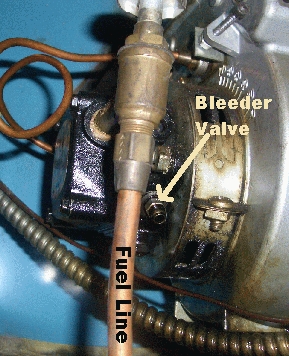
Click here to see larger image
Did you run out of oil? If you're lucky, the furnace will restart on its own after your oil tank is filled. But, if it doesn't, here's how to get it going again.
1. Try pressing the 'reset button' (usually red), on the furnace itself.
1. If it still doesn't start, you will need to bleed the fuel line as described below.
2. Gather the right tools (see 'Things You'll Need' below).
3. Shut off the furnace (there should be a toggle switch on the furnace for this). If the reset button is keeping the furnace off already (e.g. a red light "on" near reset button) turning the furnace off again is not necessary.

4. Locate the bleeder valve. The fuel pump (the thing the fuel line leads to) is probably on the left side of the burner unit. On the side of the pump, maybe at 4 or 8 o'clock position, there is a bleeder. It looks sort of like a grease fitting. It has a hex shoulder on it, like a nut or bolt and might be 3/8" inch.
5. Prepare the bleeder by loosening it with a wrench, then re-tighten loosely by about a quarter turn. Do NOT remove nut completely.
6. Put a can or cup under the bleeder to catch the fuel oil. A short section of 1/4" nylon tubing will fit over the bleeder and provide a cleaner method to transfer the bled fuel oil to the can.
7. Turn on the furnace and loosen the bleeder at the same time. It may be necessary to manually trigger the start mechanism with the reset button. The bleeder should spit fuel and air, then solid fuel. (See Tips.)
8. Tighten the bleeder, and the burner should kick in. If not, repeat Step 7. Sometimes it takes a couple of tries.
9. Once you are sure it is running, tighten the bleeder firmly with a wrench.
10. If multiple attempts at restarting the burner fail, the burner may "lock out" the reset button. To reset the reset button, press the button for 35 seconds, then release.
Tips
* When bleeding the line, let the liquid fuel come out for a short time to make sure all the sludge and/or air is out of the line. The amount depends on how long your fuel line is. Filling a 16oz cup works for a 6 foot fuel line.
* Consider contacting an oil burner service company to replace the filter and nozzle, since running out of oil probably caused sludge from the bottom of your oil tank to get into the works.
* The bled out oil can be poured back into your the tank that stores the fuel oil.
* If you use a plastic container to catch the bled out fuel, you should remove it as soon as possible. Oil dissolves plastic, and the container will lose its integrity in anywhere from a few hours to a few days.
* When it's running, the typical furnace will 'roar.' When it's not running, you'll hear nothing, or just an electronic whine.
* To ensure the furnace is operating you should be able to view an orange glow or fire through the inspection port, located on the front of the furnace.
* Depending on your furnace, #2 diesel fuel can work in a pinch if you need oil now and can't get a delivery. Depending on your usage about 5 gallons of diesel fuel will give you 5 running hours (about 1 day of use).
* In some states heating oil is dyed red. No cause for alarm.
![]() Warnings
Warnings
* You are playing with fire and fuel here, so be careful.
* Not all furnaces are alike. This process only relates to single oil line applications. If you are at all unsure please call a qualified Burner Service Technician.
* Make sure the wrench fits the bleeder properly. Don't use excessive force when loosening or tightening the bleeder. If you strip the bleeder, it could be quite expensive to have it drilled out!
* If you aren't careful, it is possible to make a BIG mess. At a minimum, you WILL get oil on your hands.
* Don't go wild on the reset button. Try it once or twice. If the furnace doesn't start, it probably won't start until you bleed the line. By resetting the furnace multiple times you run the risk of flooding the combustion chamber with fuel.
* If you decide to temporarily use diesel fuel be aware that some grades of diesel are more easily ignitable than standard #2 heating oil/#2 diesel and could create a fire hazard.
* If you decide to temporarily use diesel fuel be sure you put in enough to hold you over until the heating oil can be delivered. Repeatedly running out of fuel will pull more sludge into the burner and increase the possibility of the filters and nozzles to be replaced and/or cleaned.
* A wide-mouth container to catch some waste oil in. A metal coffee can with some sand or cat litter in the bottom to prevent splashing works well.
* 1/4" flexible tubing fit over the bleeder valve to direct smelly fuel to catch container. Although not essential it will make the process tidy.
* A wrench of the appropriate size, usually 3/8ths. A short handled fixed size wrench is best. You may be able to use an adjustable, but often there isn't enough room around the bleeder for all the excess metal.
* Something to wipe your hands and tools with when you are done (you WILL get oil on your hands IF you don't use tubing on the bleeder valve).
* A small bag of clay cat litter (not the clumping stuff). This is optional, but can be used to absorb any oil that may spill on the floor.